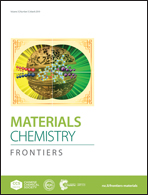V2(PO4)O/C@CNT hollow spheres with a core–shell structure as a high performance anode material for lithium-ion batteries†
Abstract
V2(PO4)O is a novel promising anode material because of its stable crystal structure, low cost, and environmentally friendliness. However, its low electronic and ionic conductivity result in poor specific capacity and rate performance, hindering its industrial application. In this study, V2(PO4)O/C@CNT hollow spheres (HSs) with a core–shell structure were successfully synthesized by a simple spray drying method. Pluronic® F-127 acted as a carbon source and template, and induced the V2(PO4)O particles to form HSs. The V2(PO4)O/C@CNT HSs were composed of uniform HSs of about 0.4–0.6 μm in diameter and carbon nanotubes (CNTs). The HS structure enhances the electronic conductivity and lithium ion transport rate of V2(PO4)O/C materials and thus helps improve the electrochemical performance. CNTs not only increase the electronic conductivity and lithium ion transport rate, but also hinder the aggregation of the HSs. These activities enhance the electrochemical performance. The lithium ion storage behavior of V2(PO4)O/C@CNT HSs is systematically studied in the potential range 0.01–3.0V. The V2(PO4)O/C@CNT HS anode can achieve a high reversible capacity of 894.9 mA h g−1 at 0.1 A g−1 and can obtain a reversible capacity of 490.4 mA h g−1 at a high rate of 5 A g−1, perhaps the best electrochemical performance demonstrated so far for a V2(PO4)O anode material (specific capacity and rate performance), indicating its promise for application as an anode material in advanced lithium-ion batteries.



 Please wait while we load your content...
Please wait while we load your content...